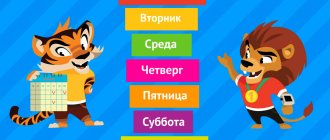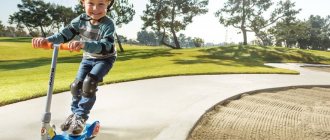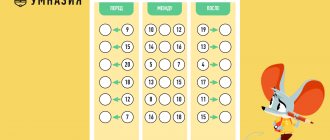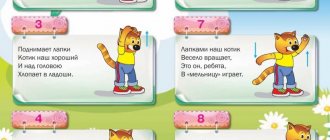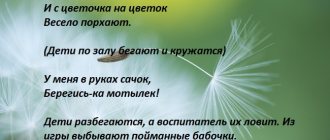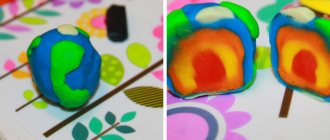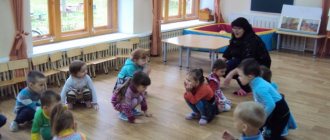Game exercises and outdoor games for preschoolers
Walk along the path (path)
Tasks. Exercise children in walking in a limited area, develop a sense of balance, dexterity, and eye.
Description of the exercise. The teacher draws two parallel lines along the floor (or places two ropes; length 2.5 - 3 m) at a distance of 25 - 30 cm and tells the children that this is a path, along which they will go for a walk. Children walk one after another, trying not to step on the line. They return in the same order. You need to walk carefully, not interfere with each other and not bump into the person in front. This exercise is good to do on the site. In the fall, you can direct a path to a tree and invite children to walk along it and bring leaves, acorns, maple seeds, which will enliven the game.
If the game exercise is carried out indoors, you can place flags and toys at the end of the path and give the task to bring them.
Go through the stream.
Tasks. To develop children's sense of balance, dexterity, and eye.
Description of the exercise. The teacher draws two lines (a cord can be used indoors) and tells the children that this is a river, then places a board across it (length 2.5 - 3 m, width 25 -30 cm) - a bridge.
“Beautiful flowers grow on this bank of the river (multi-colored scraps are scattered on the carpet), let’s collect them,” the teacher addresses the children. “But first we will cross the bridge.” Children, one after another, cross to the other side of the river (stream), collect flowers (squat, bend over), then return to their places. The exercise is performed 2-3 times. The teacher makes sure that the kids walk along the board carefully, without bumping into each other: “Be careful. Don't fall into the river."
Where is it ringing?
Tasks. To develop children's attention and spatial orientation.
Description of the game. Children stand facing the wall. The nanny hides at the other end of the room and rings the bell. “Listen carefully to where the bell is ringing, find it,” the teacher addresses the children. When they find the bell, the teacher praises the kids. The game repeats itself.
Who's quieter?
Tasks. Exercise children in walking on their toes in the indicated direction.
Description of the game. The children walk in a crowd along with the teacher. Suddenly he says: “Well, now let’s see which of you can walk quietly - quietly, on your tiptoes” - and shows. Children follow the teacher. Unnoticed, he steps aside and says: “Now everyone run to me.” Children run, the teacher praises the kids, pretends to hug everyone. You can give the task to walk quietly towards a bear or a bunny, who are sitting on chairs, and at the signal, the children should run back.
Some 2-3 year old children, when walking on their toes, hold their head unnaturally, pulling it into their shoulders. It seems to them that in this case they walk more quietly. We need to monitor this, pointing out errors, and correct them. Walking on your toes strengthens the arch of your foot. However, children should not be tired of doing this exercise for too long. The game is repeated 3-4 times.
Bubble
Tasks. To consolidate in children the ability to form a circle, gradually expand and narrow it.
Description of the game. The children and the teacher join hands and form a large circle, standing close to each other, then say:
Blow up, bubble, Blow up, big, Stay like that, Don't burst.
At the same time, everyone gradually expands the circle and holds hands until the teacher says: “The bubble has burst!” Children lower their hands and squat down, saying: “Clap.” After the words “the bubble burst,” you can invite the children, still holding hands, to move to the center of the circle, saying “sh-sh-sh.” The kids inflate the bubble again, move back, forming a large circle.
The text must be pronounced slowly, clearly, involving children in repeating the words after the teacher. Instead of a quatrain, you can make sounds that imitate inflating a balloon: “pf-pf-pf.” When the balloon bursts, clap your hands and sit down.
Aircraft
Tasks. Exercise children in the ability to run without bumping into each other, and perform movements when given a signal.
Description of the game. Children sit on chairs located on one side of the room or playground. The teacher makes rotational movements of his hands in front of his chest and says: “rrrr”, shows how to start the engine of an airplane. Then he turns to the children: “Get up, get ready to fly, start the engines!” Everyone repeats the hand movements. At the signal “let’s fly,” children spread their straight arms to the sides (the wings of an airplane) and run in different directions around the room or playground. At the “boarding” signal, everyone goes to their chairs and sits down on them. The game repeats itself.
The teacher first shows the movements, and then completes the entire game task together with the children.
Train
Tasks. Train children to walk forward in small groups. First, holding each other, then freely moving your arms, bent at the elbows, begin and end the movement exactly at the teacher’s signal.
Description of the game. The teacher helps several children stand next to each other and says: “Let’s play train. I will be the locomotive, and you will be the carriages,” then he stands in front of the children. The locomotive blows its whistle, and the train begins to move, first slowly, then faster. The teacher leads a column of children in one direction, then in another, finally stops and says: “Stop.” Through
After some time, the locomotive blows its whistle again and the train sets off.
The role of the locomotive is first performed by the teacher; only after several repetitions does he involve the most active child in the role of leader. The locomotive moves slowly so that the children's carriages do not lag behind each other. At first, each child holds on to the clothes of the person in front, and then the children walk freely one after another and move their arms, imitating the movement of the wheels of a steam locomotive, in time with the spoken words “chu-chu-chu.” Children can line up one after another at random. When the game is repeated several times, the kids are asked to get off at the bus stop: pick berries, mushrooms, jump, take a walk. Having heard the whistle, the children must quickly form a column behind the locomotive.
Sunshine and rain
Tasks. To develop in children the ability to run in all directions, without bumping into each other, and to quickly respond to a signal.
Description of the game. At first, when you get acquainted with the game, a simplified version is given. Children sit on chairs or a gymnastic bench. At the teacher’s signal “sun”, everyone goes for a walk, runs, plays, etc. At the signal “rain” they quickly return to their places.
You can use an umbrella in the game; the teacher opens it at the second signal - “rain”. Children run to the teacher to hide under an umbrella.
After repeated repetition, the game can be complicated: chairs are placed at some distance from the edge of the playground or the wall of the room, the children squat down at the back and look out the window (into the hole in the back), the teacher says: “The sun is in the sky! You can go for a walk." The kids run all over the playground. At the signal “it’s raining, hurry home,” they run to their seats and sit behind the chairs. The teacher says again: “Sunny! Go for a walk!” the game is repeated.
Catch the ball
Tasks. Develop in children the ability to maintain the required direction while walking and running and change it depending on the current situation, teach them to run in different directions, not touch each other, catch the ball, develop attention and endurance.
Description of the game. The teacher shows the children a basket with balls and invites them to stand next to him along one side of the room or playground. “Catch the ball,” says the teacher and throws balls (according to the number of children) from the basket, trying to get them to roll in different directions as far as possible. Children run after the balls, take them (each one ball), bring them to the teacher and put them in the basket. The game repeats itself.
In the game you can use multi-colored wooden or plastic balls. Having put them in a basket, the teacher invites the children to see how beautiful the balls are, telling them what color they are. Then he pours them out: “That’s how the balls rolled. Catch them up and put them in the basket.” The teacher makes sure that each child tries to catch up with one ball. At first, the game is played with a small group of children, gradually the number of players increases.
Birds in nests
Tasks. Exercise children in running in different directions, in the ability to hear the teacher’s signal, and navigate in space.
Description of the game. On one side of the playground or room, hoops are laid out freely according to the number of children. Each child stands in his own hoop - this is a nest, a bird lives in it. At a signal, the birds fly out of their nests and scatter throughout the area. The teacher feeds first at one end, then at the other end of the playground: the children squat down, hitting their knees with the tip of their fingers - they peck at the food. “The birds have flown to their nests!” - says the teacher, the children run to the hoops and stand in any free hoop. The game repeats itself.
When the game is mastered by the children, you can introduce new rules - lay out 3-4 large hoops - “several birds live in the nest.” At the signal “the birds have flown to their nests,” children run, 2–3 kids stand in each hoop. The teacher makes sure that they do not push each other, but help each other to get into the hoop, and use the entire area allocated for the game.
Sparrows and car
Tasks. Exercise children in running in different directions, without bumping into each other, in the ability to start a movement and change it at the teacher’s signal, and find their place.
Description of the game. Children sit on chairs or benches on one side of the room or area - these are sparrows in nests. The teacher stands on the opposite side with a hoop in his hands. It depicts a car. At the signal “the little sparrows have flown onto the path,” children run around the playground, easily waving their arms. The teacher says: “The car is moving. Fly, little sparrows, to your nests!” The car drives out, the sparrows fly away - the children run and sit down in their seats, the car returns to the garage.
First, the teacher shows how sparrows fly and how they peck grains. Children repeat all movements after the teacher, and then the car is included in the game. Only after repeated repetitions can this role be assigned to the most active child. The car moves calmly to allow children to find their place.
Shaggy dog
Tasks. Teach children to listen to the text and quickly respond to the signal.
Description of the game. The child pretends to be a dog, he sits on a chair at one end of the area and pretends to be sleeping. The rest of the children are at the other end of the room beyond the line - this is the house. They quietly approach the dog, and the teacher says:
Here lies a shaggy dog, with his nose buried in his paws, Quietly, quietly, he lies, either dozing or sleeping. Let's go up to him, wake him up and see what happens.
The dog wakes up, gets up and starts barking. The children run into the house and stand over the line. Then the role of the dog is assigned to another child. The game repeats itself.
Chicken - Corydalis
Tasks. Train children to quickly respond to signals and run while dodging.
Description of the game. The teacher plays the role of a chicken, the children act as chickens. One child (more active) is a cat. The cat sits on a chair to the side. The teacher walks with the children around the entire playground and says:
A crested hen came out, with yellow chicks, the hen clucked: “Ko-ko, Don’t go far.”
Approaching the cat, the teacher says: On the bench by the path, the cat has laid down and is dozing... The cat opens its eyes and catches up with the chickens.
The cat opens its eyes, meows and runs after the chickens; they run away to the opposite side of the room, where their home is marked with a line. The cat doesn't catch chickens. The teacher protects them, spreads his arms to the sides and says: “Go away, cat, I won’t give you chickens.” A new cat is then assigned and the game is repeated.
Beetles
Tasks. Train children to run in all directions, change movements when given a signal, and be attentive.
Description of the game. The game is played with a tambourine and musical accompaniment. At the signal “the bugs have flown” (running music is played or the teacher lightly, rhythmically hits the tambourine), the children run scattered throughout the room or playground. At the signal “the beetles have fallen”, the rhythm of the beats changes (you can simply shake the tambourine) or the music changes - the children lie on their backs, make free movements of their arms and legs - the beetles flounder. At the signal “the beetles have flown,” the children stand up. The game repeats itself. When the game is mastered by the children, changes in movements occur in accordance with the nature of the musical accompaniment or with a change in the rhythm of hitting the tambourine.
Cat and mice
Tasks. Exercise children in climbing (or crawling), the ability to respond to a signal, and perform movements in accordance with the text of the poem.
Description of the game. The game is played with a subgroup of children (8 - 10) in a room (on a carpet) or a lawn covered with soft grass. In the middle of the room (on the carpet) or lawn, a gymnastic ladder is placed on its edge or a cord is pulled. On one side there is a fenced off space - a house of mice. They choose a cat. They sit on a chair or stump. The mice are sitting in holes behind the stairs. The teacher says:
The cat is guarding the mice, pretending to be asleep.
The mice crawl out of their holes (climb between the slats of a ladder or crawl under a cord) and run around. After a while the teacher says:
Hush, mice, don’t make noise, you won’t wake up the cat...
The cat gets off the chair, gets on all fours, arches its back, loudly says “meow” - and catches the mice, they run into their holes (do not crawl under the cord or ladder slats). The role of the cat is first assigned to the most active child, then other children are involved in this role. The game is repeated each time with a new cat.
My funny ringing ball
Tasks. Teach children to jump on two legs, listen carefully to the quatrain and run away only when the last word is spoken.
Description of the game. Children sit on chairs on one side of the room or area. At some distance in front of them there is a teacher, he has a ball. He shows how easily and high the ball jumps if you hit it with your hand, and says:
My cheerful ringing ball, where did you start galloping? Red, yellow, blue, Can't keep up with you!
Then the teacher calls 2 - 3 children, invites them to jump at the same time as the ball hits the floor and repeats the exercise again, accompanying it with reading a quatrain. After this, the teacher quickly says: “I’ll catch up now!” the kids run away, and the teacher calls other children. Gradually all children join the game. They are balls.
Chickens in the garden
Tasks. Exercise children in climbing, running, squatting, teaching them to navigate in space and quickly respond to a signal.
Description of the game. In the middle of the room they limit a small area - a vegetable garden. Not far from it, on one side of the room, a chair is placed - this is the watchman's house; on the other side, at the level of the child's chest, a rail is strengthened on the racks or a ribbon is pulled - a house for chickens.
The role of the guard is first performed by the teacher, and then by more active children. The rest are chickens. At the teacher’s signal “go, hens, for a walk,” the chickens crawl under the fence (slat), make their way into the garden, run, look for food, and cackle. The watchman notices the chickens and chases them away - he claps his hands, saying: “Shoo, shoo!” The chickens run away, crawl under the slats and hide in the house. The watchman walks around the garden and sits down again. The game repeats itself.
If the game is played at the beginning of the year, then the area of the garden is not indicated. Children run around using the entire room.
Balloon
Children form a circle holding hands. Together with the teacher they walk in a circle.
My mother and I went to the store and bought a balloon there. We will inflate the balloon, we will play with the balloon.
(They stop, turn to face the center of the circle, hold hands, perform a “spring”.)
Balloon, inflate! Balloon, inflate!
(They go back in small steps and inflate the balloon.)
Puff up big and don't burst!
(Clap their hands.)
The balloon flew away, hit a tree and... burst!
They raise their arms and swing them from side to side; then they put their hands on their belts, slowly squat, saying: “Sh-sh-sh-sh”
In an even circle
Children holding hands walk rhythmically in a circle while reading a poem.
In an even circle, one after another, we go step by step. Stay where you are! Together, let's do this!
With the end of these words, they stop and repeat the movement that the teacher shows, for example, turn, bend, squat, etc.
Come along with us!
The children stand scattered. The teacher pronounces the text together with the children and shows the movements.
Let's join us (raise their arms to the sides) Stomp our feet (stomp our feet while standing still), Clap our hands (clap our hands). Today is a good day! (raise straight arms up and to the sides.)
It's me!
The teacher shows the children how to perform the movements and pronounces the text expressively. Children perform movements imitating an adult.
These are the eyes. Here! Here! (show first the left eye, then the right eye.) These are the ears. Here! Here! (they grab the left ear first, then the right.) This is the nose! It's a mouth! (with your left hand you show your mouth, with your right hand you show your nose.) There’s a back! There's a belly! (The left palm is placed on the back, the right palm on the stomach.) These are hands! Clap clap! (extend both hands and clap twice.) These are legs! Top, top! (put their palms on their hips and stomp twice.) Oh, tired! Let's wipe our brow. (Reach your right palm across your forehead.)
Handles - legs
Children stand scattered around the hall. The teacher pronounces the words of the test and shows the movements. The children do it. Everyone clapped their hands. More friendly, more fun! (clap their hands.) Our feet pounded louder and faster! (knocking their feet.) Let's hit the knees. Hush, hush, hush! (claps on the knees.) We raise our arms, our arms Higher, higher, higher! (slowly raise their hands.) Our arms spun (turn our hands to the right - left), and dropped again. They circled, circled and stopped (they lower their hands). The cockerel stands on a leg and pecks peas in the garden (they stand on one leg, with their hands they depict how the cockerel pecks). - Oh, my leg is tired, I walk around a little (walking in place; do the same with the other leg). The mother elephant stomps quietly (walks quietly), and the baby elephant Romka stomps loudly (they walk, raising their knees high). He stomps, dances (they dance in a squat), and waves his proboscis (they wave their hand). The bear woke up in the spring (hereinafter the movements according to the test), Stretched, smiled, Turned around, looked around, Scratched, combed his hair. He bent down and washed himself with water from the stream (stretch up on toes, arms to the sides. Further movements according to the text). Dressed up and went through the forest to play tricks. Beware, forest people, a hungry beast is coming! (walking like a bear.)
Author: Chulkova Olga Anatolyevna, teacher of the first quarter. category MKDOU "Kindergarten No. 24" Degtyarsk, Sverdlovsk region
The article is published in the author's edition.
Card file “Physical education in the air” in the preparatory group
Nadezhda Razumova
Card file “Physical education in the air” in the preparatory group
Card index " Physical education in the air " in the preparatory group .
Complex No. 1 (September)
.
Objectives: Encourage children to run randomly. In games and relay races, develop children's endurance, agility, speed, and balance. Continue learning to throw and throw the ball several times in a row in different ways.
1 hour Walking and running are normal. Run in all directions at the signal.
2h. 1. Game “Don’t knock down the pin”
. Children stand in 2 columns, opposite the pins.
On command, children run around the pins one after another in a “snake”
, trying not to knock them over. The column that knocks down the fewest pins wins.
2. Game exercise “To the race”
. Children line up in 3-4 columns on one side of the site. At the signal, the first ones run to the races, etc.
3. Exercise “Tossing the ball”
. Throwing a ball and catching it with 2 hands.
4. Walk along a narrow path, keeping your balance.
5. “Pass the ball”
. Pass the ball in a column from the first to the last player.
6. Passing the ball between the legs from the first to the last player in the column.
7. Preparatory group . Game "Throw the ball"
. Throwing the ball in pairs in different ways.
3h. Walking, running, jumping along the path around the kindergarten. Breathing exercises.
Complex No. 2 (September)
.
Tasks. Strengthen different types of walking and running. In games and relay races, develop agility, speed, and endurance. Teach children to run at a slow pace and breathe through their nose.
1 hour Walking is normal. Run as usual, raising your knees high. Walking with long strides.
2h. Relay races.
1. "Move the pin"
. Children stand in 2 columns. On command 1, they run, take the pin, return and give it to the next one. 2-run and put the pin in place, etc.
2. “Whose team will build faster”
. On command they scatter, on signal they form up.
3. "In places"
.
At the signal “to go for a walk”
the children perform any movements; at the signal
“take their places”
they form a column or a circle.
4. "Tarnish the Last One"
. Children are divided into 2 columns. The first player on each team tries to stain the last player.
5. P/I “Sly Fox”
.
6. P/I “Mousetrap”
.
6. Preparatory group . P/I “We are funny guys”
(with complication)
.
3h. Healthy run around the kindergarten. Walk at a slow pace.
Complex No. 3 (October)
.
Tasks. Teach children to catch, throw, throw a ball with two hands in different ways. In outdoor games, reinforce running with dodging. When jogging around the village, teach children to breathe through their nose.
1 hour Walking is normal. Slow run, at the signal - in a circle. (3-4 times)
.
2h. 1. Basketball. Their basketball player stance is throwing the ball into the hoop.
2. Throwing the ball in pairs to each other from a distance of 2m. V
3. Throwing the ball against the wall from the chest with 2 hands and catching it.
4. Sports game “Touch the ball”
. Children in pairs throw the ball, the third runs between them and tries to touch the ball with his hand. If he succeeds, then he takes the place of throwing the ball.
5. P/I “Traps in pairs”
. Children run in all directions, a pair of drivers with their hands clasped catches up with those running away.
6. P/I “Crucian carp and pike”
.
Children - "crucian carp"
- run around the playground,
"pike"
- stain.
7. 7. Preparatory group . P/I “Traps with a hoop”
.
3h. Healthy run around the kindergarten. Walk at a slow pace.
Complex No. 4 (October)
.
Tasks. Strengthen different types of X and B. Strengthen the motor skills of children in outdoor games and play exercises.
1 hour Walking is normal, changing lanes in pairs. Run at a slow pace in pairs.
2h. 1. Running at a slow pace and overcoming obstacles. Walking.
2. Game “Hit the Hoop”
. Throwing bags into a hoop in different ways.
3. Game "Gymnasts"
. Deep squats with a bag on the head. Keep your back straight.
4. P/I “Traps with a ball”
.
At the signal, the children run away, the “trap”
throws the ball at the child’s legs, and whoever it hits becomes
the “trap”
.
5. P/I “Squat traps”
.
The “trap”
stains only those children who are running, and those who are crouched are in
the “house”
.
6. Walk as usual, raising your knees high, with an extended step to the right and left.
7. 7. Preparatory group . Climbing in different ways around the sports complex on the site.
3h. Slow running. Walking. Breathing exercises.
Complex No. 5 (November)
.
Tasks. Reinforce different types of X and B. Continue learning to climb the gymnastic ladder in alternating steps. Develop fast running and dodging in children.
1 hour. Walking with hand movements: up, to the sides, in circular movements. Slow running.
2h. 1. Climbing gymnastic stairs in alternating steps.
2. P/I “Catch up with your partner”
. At a signal, one child catches up with the other, then they change.
3. Exercise “Race in pairs”
. Children run in pairs to the other side of the playground.
4. Exercise “Who takes the fewest steps”
. Walking with long steps from one side of the platform to the other.
5. P/I “Wolf in the Moat”
.
In the middle of the site there is a “ditch”
made of skipping ropes.
On one side there are “hares”
, on the other there is
a “field”
.
The Wolf in the Moat
catches children as they jump over and run onto the field.
6. Game exercise “Stop and Run”
. At a signal, children run, at a signal they stop. The child who runs first wins.
7. Preparatory group . P/I “Trap with a hoop”
.
3h. Slow run for 3 minutes. Walking. Breathing exercises.
Complex No. 6 (November)
.
Tasks. Teach children to throw objects at a target. Teach children to dribble the ball with a stick in short steps. Strengthen running while overcoming obstacles.
1 hour Walking is normal, with side steps to the right and left. Run at an average, slow pace.
2h. 1. Exercise “Fast and accurate”
. Throwing objects at a target.
2. Dribble the ball with a stick, like a club.
3. Climbing stairs in alternating steps.
4. Running at an average pace, overcoming various obstacles.
5. P/I “Flock”
.
Children are a “flock of birds”
, with
the “leader”
.
They run around the site. At a signal, each bird looks for shelter (a bush, a tree, the side of a sandbox, etc.)
.
6. P/I “Two frosts”
7 Preparatory group . P/I "Hunters and Beasts"
.
3h. Walking around the kindergarten. Breathing exercises.
Complex No. 7 (December)
.
Tasks. To develop children's eye and endurance. Develop agility, speed, endurance in outdoor games. Reinforce the “right”
IP when throwing.
1 hour Walk as usual, turn around on command. Normal running, jumping on the right and left legs.
2h. 1. Dribble the puck with a stick (stick and ball)
from one side of the site to the other.
2. Game "Snipers"
.
Throwing objects at a target (distance 2.5 m)
.
3. Game "Be careful"
.
On command, children run to a landmark, each from a different I.P. (standing sideways in the direction of movement, with their backs, squatting)
.
4. P/I “Traps with a hoop”
.
5. P/I “Tails”
.
6. 6. Preparatory group . P/I “Dog”
(with a ball)
.
3h. Slow running. Walking.
Complex No. 8 (December)
.
Tasks. Strengthen throwing objects at a target and into the distance from I.P. Teach children to run at a slow pace, breathing through their nose.
1 hour Walking is normal. Run as usual, raising your knees high, jumping from foot to foot.
2. Game exercise “Jumpers”
. Jumping on one leg from hoop to hoop, energetically assisted by swinging your arms.
3. Game exercise “Who will throw further?”
. Throwing objects into the distance and at a target from a distance of 3-4 m.
4. Game “Stop-Run”
(complex No. 5)
.
5. P/I “Day and Night”
.
6. P/I “The sea is agitated”
.
7. Preparatory group . P/I "Bouncer"
.
3h. Slow run 3 minutes around the kindergarten (300 m)
. Walking. Breathing exercises.
Complex No. 9 (January)
.
Tasks. Teach children to use different types of jumps, methods of throwing and passing the ball in games. Develop endurance, jumping ability, agility, speed of movement. Develop the muscles of your arms and legs while hanging on a ladder.
1 hour Walking is normal, with long steps. Running is normal.
2h. 1. Game “Catch up with your partner”
.
(Complex No. 5)
.
2. P/I “Who will do the least jumps”
. Children at the starting line. At the signal, jump (on 2 legs, on 1 leg, on the right and left, trying to reach the finish line in fewer jumps.
3. Game “Ball in a Circle”
. Quickly pass the ball around. Whoever falls is out of the game.
4. Game "Hockey"
. Gymnastic sticks, goals, 2 chairs (distance 3 meters, puck, ball. The goal is to throw the ball into the goal.
5. "Snow Shooting Range"
.
Children use snowballs (objects)
to knock down cubes, skittles, etc.
6. P/I “Dog”
.
Children in a circle, the driver in the middle is a “dog”
.
Children throw the ball to each other, the “dog”
tries to intercept it.
7. Preparatory group . Hanging on a gymnastic ladder, raising legs to the “corner”
.
3h. Health jogging around the village at a slow pace. Walking. Breathing exercises.
Complex No. 10 (January)
.
Tasks. In outdoor games, develop dexterity, speed of movement, and endurance. Continue to teach children to breathe through their nose when running in winter.
1 hour Walk, raising your knees high, on the count of 3, clap overhead. Running at a normal pace.
2h. 1. P/I “Traps in pairs”
. Children scatter, trap in pairs, without separating their hands, they catch those running away.
2. P/I “Bouncer”
. The driver runs around the playground, trying to hit the players with snowballs. Stained children become bouncers.
3. P/I “Mousetrap”
.
4. P/I “We are funny guys”
.
5. P/I “Have time to take a seat”
. Children in a circle are counted in numerical order. The driver in the center calls any 2 numbers and these children must quickly change places. The driver’s task is to take any place.
6. P/I “Snake”
.
Children stand in a column, hands on the shoulders of the person in front. The task is to walk like a snake
without releasing your hands.
7. Preparatory group . Throwing snowballs (balls)
into a basketball basket.
3h. Walking around the kindergarten. Breathing exercises.
Complex No. 11 (February)
.
Tasks. Strengthen children's throwing skills in different ways. Develop children's dexterity, coordination, and endurance.
1 hour Walking, clapping in front of you. Normal running, hopping.
2h. 1. Climbing stairs in alternating steps.
2. Game “Knock down the pin”
. Children use sticks or sticks to knock down objects with pucks or balls.
3. Game “Snipers”
(complex No. 7)
.
4. Game “Who takes the fewest steps”
(complex No. 5)
.
5. Outdoor game “Snow Queen”
(whoever she touches, the child
“freezes”
in place).
6. Preparatory group . Outdoor game “We are funny guys.
3h. Healthy running at a slow pace around the kindergarten. Walking.
Complex No. 12 (February)
.
Tasks. Strengthen children’s motor skills and abilities in outdoor games. Develop physical qualities: speed of movement, agility, endurance, jumping ability.
1 hour Walking as usual, “snake”
.
Running is normal, “snake”
.
2h. 1. Game “Quickly to places”
.
At the signal “to go for a walk”
, the children run away.
At the signal “take your places”
, they will form a column.
2. "Tarnish the Last One"
. Children are divided into 2 teams, holding hands. At the signal, the first player of each chain must stain the last player of the other team.
3. "Who has more"
. Various toys are laid out on the playground. Children run around them, and at the signal they need to collect as many toys as possible.
4. Game “Flock”
(complex No. 6)
.
5. “Be careful”
(complex No. 7)
.
6. P/I “Dog”
(complex No. 9)
.
7. Preparatory group . Outdoor game "Mousetrap"
.
3h. Run at a slow pace. Walking.
Complex No. 13 (March)
.
Tasks. To develop children's eye for throwing, coordination and balance, speed of movement and reaction in games.
1 hour Walking is normal, with circular movements of the arms. Running at a slow pace, side gallop.
2h. 1. P/I “Hot hand”
. Children stand in a circle, put their hands forward, the leader is in the center. He slaps hands, and whoever he touches leaves the circle.
2. Balance exercise “Don’t lose the bag”
. Place the bag on top of the hat and walk along the line, keeping your balance.
3. Outdoor game “Flies or doesn’t fly”
(with a ball)
.
4. "Footprints"
. Follow in the footsteps of the teacher or child, maintaining balance and balancing.
5. "Don't let the ball touch your feet"
.
Children in a circle, leading in the middle with a stick (stick)
with a ball. His task is to hit someone at the feet, the children are jumping up and down.
6. Throwing bags at a target in different ways.
7. Preparatory group . Outdoor game "Burners"
.
3h. Healthy run around the kindergarten. Walking. Breathing exercises.
Complex No. 14 (March)
.
Tasks. Teach children to roll a hoop in a straight line. Develop children's jumping ability in games. Teach children to assume the pose of a basketball player when throwing the ball into the basket.
1 hour Walking is normal, with various arm movements. Snake running
, back forward.
2h. 1. "Jump the Line"
. Jumping on 2 legs sideways over a line.
2. “Quickly roll the hoop to the flag”
. Children stand on one line and roll the hoop to a landmark.
3. "Jump on 1 leg"
. Children jump one after another on one leg for 3-4 meters, then back on the other leg.
4. Running a race over a distance of 20-25 meters.
5. "Hit the ball into the hoop"
. Children take turns throwing the ball into the hoop with 2 hands from a basketball player’s stance.
6. Run with long strides along the track with an arm swing.
7. 7. Preparatory group . Outdoor game “Knock down the pin”
.
3h. Health-improving walking around the kindergarten, alternating with jumping. Walk at a slow pace.
Complex No. 15 (April)
.
Tasks. Strengthen climbing stairs with children in alternating steps, throwing the ball to each other in pairs in different ways. Strengthen children's motor skills in outdoor games.
1 hour Walking is normal, with jerking of the arms. Run at a slow, medium and fast pace at a signal.
2h. 1. “Race in pairs”
(complex No. 5)
.
2. P/I “Catch up with your mate”
(complex No. 5)
.
3. "Jumping"
. Children stand on the starting line, pushing off with 2 legs and jumping as far as possible, making big jumps.
4. Climbing exercise. Climbing stairs in alternating steps.
5. Exercise “Throwing the ball”
. Throwing the ball in pairs in different ways.
6. P/I “Dog”
(in a circle)
.
7. Preparatory group . Outdoor game "Football"
. Children are divided into pairs and practice kicking the ball to each other.
3h. Healthy run around the kindergarten. Walking. Breathing exercises.
Complex No. 16 (April)
.
Tasks. Teach children to compete together in relay races, helping each other. Run in pairs without releasing your arms. To develop dexterity, endurance, and reaction speed in children.
1 hour Walking is normal. Running is normal, at a signal - in all directions.
2 hours Relay race:
1. “Whose team will build faster”
. On the 1st signal - run in all directions, on the 2nd signal - they will form in 2 columns.
2. "Pass the ball"
. Children pass the ball from the captain to the last in the column and back over their heads.
3. "Kangaroo"
. Jumping on 2 legs to a landmark and back - normal running.
4. "Pass the flag"
. Children run one by one to the landmark and back, passing the flag to the next one in the column.
5. "Running in pairs"
. Children line up in pairs one after another. Speed running in pairs to a landmark and back, without releasing your arms.
6. "Running in Threes"
. Same as in pairs.
7. Preparatory group . Outdoor game “The sea is agitated once”
.
3h. Walking. Jumping around the kindergarten on the track. Breathing exercises.
Complex No. 17 (May)
.
Tasks. Teach children to compete harmoniously and amicably as a team, helping each other. To develop endurance, speed of movement, and high-speed running in children.
1 hour Walking, changing the position of the hands (up, forward, to the sides, on the shoulders, on the waist)
.
Normal running, side gallop.
2 hours Relay games: Children are divided into 2 teams.
1. Run to the landmark, jump on 1 leg around the pin, run back.
2. Jumping sideways to a landmark and back.
3. Run backwards.
4. Running while passing various objects (flags, sticks, etc.)
.
5. Running in pairs and trios.
6. Jumping on 2x, 1 leg.
7. Preparatory group . Strongman Competition
.
Who can squat and stand on 1 leg more times (boys and girls separately, change legs)
.
3h. Walking, running, jumping along the recreational path around the kindergarten. Breathing exercises.
Complex No. 18 (May)
.
Objectives: To consolidate motor skills and abilities in game exercises: climbing, jumping, throwing and throwing, balance. Develop physical qualities in children.
1 hour. Walking while counting: 1-hands forward, 2-up, 3-to the sides, 4-to the waist. Running is normal.
2h. 1. P/I “Knock down the pin”
. Children knock down pins with different objects and in different ways.
2. Jumping rope in different ways.
3. Running long jump.
4. Throwing a ball against a wall and catching it in different ways.
5. Preparatory group . Jumping with a ball or bag clamped between your legs at a distance of 3-4 meters.
3h. Walking, running, jumping along the path around the kindergarten. Breathing exercises.
1. Throwing the ball up and catching it with both hands (at least 20 times in a row).
2. Throwing the ball up and catching it with one hand (at least 10 times in a row).
3. Throwing the ball to each other with a clap, with a turn, with a bounce off the ground, in an oblique direction.
4. Throwing the ball to each other in different positions: standing with your face and back, kneeling, sitting cross-legged, lying down.
5. Rolling a medicine ball at each other.
6. Throwing a medicine ball forward from below, from the chest, over the head back.
7. Hitting the ball on the ground alternately with one and the other hand several times in a row.
8. Hit the ball on the ground with both hands, running at a distance of 6-8 m.
9. Hit the ball on the ground with one hand, moving forward in a straight direction.
10. Hit the ball on the ground, moving in a circle.
11. Hit the ball on the ground, moving like a snake.
12. Throwing at a horizontal target with the right and left hands at a distance of 4-5 m.
13.Throwing into the distance at a distance of 6-12 m with the right and left hand.
14. Throwing at a vertical target with the right and left hands.
15. Throwing at a target from starting positions kneeling, sitting, lying down.
16. Throwing at a moving target with the right and left hands.
17.Throwing into the distance from several steps. .
18. Throwing the ball into a basketball basket from a place and from 2-3 steps.
19. Hitting the ball through the net by several players with a pass to each other (elements of volleyball).
20. Throwing and catching a ball from a wall with different tasks: with a bounce off the ground, with a turn in a circle, in an oblique direction, with jumping over a bounced ball.
21. Throwing objects of different weights and shapes into the distance and upwards (balls, bags, sticks, cardboard discs, rods - darts, etc.).
Guidelines . In the preparatory group, the teacher tries to reinforce the correct ways for children to perform
rolling, throwing and catching, throwing at a target and into the distance. Significantly increases with
This is the role of independent actions with the ball. Good ball control allows children to be offered more complex tasks: throwing and catching in different positions (standing with their face and back, kneeling, sitting cross-legged, lying down, (picture). Children 6-7 years old can throw a medicine ball with two hands in different ways: from below, from the chest, from behind the head.Tasks become more difficult, including hitting the ball on the ground with two and one hand (picture on the right).
The teacher seeks from children good control over the movement of the ball, the ability to gently push it away with their fingers, and hit the ground on the side of their foot. Training in dribbling the ball with the right and left hands is required. If the children complete the task easily and at ease, you can offer to dribble the ball along a path bounded by lines, zigzag between objects, around a large hoop, trying to complete the movement as quickly as possible. It is good to combine dribbling the ball with throwing it into the basketball basket.
Children throw at a target much more accurately, so it is advisable to reduce the size of the target to 15-10 cm and increase the distance to it. A moving target is introduced, and outdoor games like “Knock the Hoop Down” are used more often.
Throwing and throwing skills are consolidated in games that bring together groups of children: ring throws (horizontal, inclined), serso. Sports exercises should also be used more widely: table tennis, gorodki, badminton. At the play wall, children improve their movements; they themselves can think of interesting ways to hit and catch the ball: from under the hand, in a jump, in a squat, standing with their backs, etc.
Exercises and games for children 6-7 years old
Accurate strike . Two teams of 8-10 children line up columns one at a time, one against the other. Between them there is a hoop or a drawn circle (diameter 1 m). At the signal, the first from one team throws the ball into the center, circles at an angle so that it bounces to the first from the other team, and moves to the side. Throws from the first player of the second team to the second player from the first team. So, taking turns, the children of both teams throw and catch the ball. The team that finishes the game earlier or has fewer misses wins.
Rules: throw the ball into the hoop; if the ball hits the hoop, the throw is performed again; the child who did not catch the ball catches it again, but the next child in the column throws it to him.
Don't miss the ball . Children are distributed in pairs, each team has a ball. One of the pair hits the ball on the floor the agreed number of times (4-6) and passes the ball to the second in the pair. The winner is the pair that manages to keep the ball in play longer than others.
Rules: the ball is passed without stopping; the player who lost the ball is eliminated from the game, and his partner waits until the one who lost the ball comes out of any pair, and continues the game with the remaining player.
Passed it on - sit down . The players line up in 3-4 columns. In front of each, at a distance of 1 m, there are drivers in circles, they each have a ball. At the signal, each driver throws the ball to the first player in his column. Having caught the ball, the child throws it to the driver and sits on the ground. The drivers throw the balls to the second player, then to the third player, etc. Having received the ball from the last player of his team, the driver raises it up, all members of his team quickly jump up. The team whose driver picked up the ball first and all the children managed to get up quickly wins.
Rules: the one who dropped the ball must pick it up, stand in place and throw it again to the driver, having thrown the ball, immediately sit on the ground, cross-legged; all players stand up after their driver has raised the ball up.
Knock down the hoop . Two children roll a hoop intertwined with strings along the path to each other. Two others, located on opposite sides, throw a soft ball, trying to knock down the hoop.
Rules: throw into the hoop without going beyond the line; Those who knocked down the hoop change roles with those who rolled.
Throw it, catch it! The players throw the ball over a stretched rope (height 1.2-1.5 m), run forward under it and catch the ball immediately or after bouncing off the ground.
Defense of the fortress. “They take three sticks, tie them at the top and place a rubber or volleyball ball on them - this is a fortress that the driver protects. The rest of the players, standing in a circle, throw the ball among themselves. They try to hit the ball at a convenient moment, when the driver turns away. The driver does not allow this to be done. The one who hits becomes the driver. .
Rules: you can throw the ball in a circle in any direction; The driver hits the flying ball in any way - with his foot, his hand.
Who is faster. Two players stand opposite each other at a distance of 10 m. Between them in a circle stands a small town or a tall cube. Children try to knock him down with a ball. The one who succeeds moves the town one step closer to himself. The one who moves the object closest to himself wins.
Catch the ball. Children are distributed in groups of three. Two of them stand at a distance of 2-3 m and throw the ball to each other. The third stands between them and tries to catch the ball or touch it with his hand.
Rules: the driver who touched the ball changes place with the one who threw the ball; The driver can catch up with the ball that has rolled away after an unsuccessful throw.
Shot into the sky . Children are divided into two teams and located around a outlined circle with a diameter of 10-12 steps. Two players from one and the other team go out into the circle with tennis balls and throw them vertically upward as high as possible. Whose ball stays “in the air longer” gets one point.
Rules: throw the ball up at the same time at the signal; Those who threw them take the balls after they bounce off the ground.
Horizontal target . Several concentric circles are drawn on the ground 4-5 steps from the throwing line. Children take turns throwing a regular or medicine ball with both hands from behind their heads. The hit is scored - the closer, the fewer points.
Rule: Falling outside the circle does not count.
Play, play, don't lose the ball! Children are located on the playground. Everyone plays with the ball, performing actions of their own choosing: throwing it up and on the ground, hitting the ball on the spot and in motion; throws the ball into the wall, into the basket. After the teacher’s signal, everyone must quickly raise the ball up.
Rules: play with the ball without disturbing your teammates, find a free space on the court; Those who fail to pick up the ball at the signal receive a penalty point.
Pass the ball. On the path, 8-10 pegs are driven into the ground at a distance of 1.5 m from one another. The player places the ball on the ground and moves it with his foot along the path, going around the pegs first to the right, then to the left (as if in a “snake”).
Rules: be sure to circle all the pegs with the ball without missing them; catch the rolled ball, put it in its place and continue rolling.
Basket target. A small basket is hung from a tree branch and swung. 2-3 players stand behind a steeple, marked at a distance of 3-4 steps from it, and try to throw some small objects into the basket, for example, one - fir cones, another - pine cones, the third - acorns. When the basket stops swinging, the abandoned items are counted. The one who has more items in the basket wins.
Rules: when throwing, you cannot enter the circle; throw one item at a time into the basket in any way.
Volleyball with balloons. Stretch the rope at approximately a height of 1.2 - 1.5 m. Tie two balloons together, into which you can pour a few drops of water. On both sides of the rope there are teams of 3-5 children in each: the players hit the balls, trying to drive them to the opponent’s side and not letting them fall on their side.
Rules: try to play together, passing the balls to the one who is more comfortable to return them to the other side; the team on whose side the balls landed is awarded a penalty point; Do not hold the balls with your hands, but hit them.
